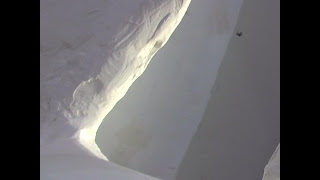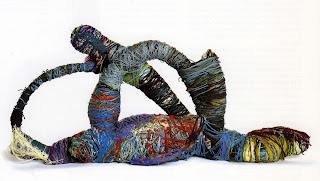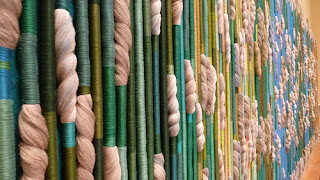Senior, Ted Selden is a videographer interested in taking his viewers on a mysterious journey through a world unknown. He was originally involved theater, and his love for storytelling and mystical adventure is prominent in his video art.
Rachel: Tell us about your transition from theater to video?
Ted: I love theater because it tells stories. I love telling stories. I originally made the switch to video because it was a form of storytelling I would have a lot more control over. Video, as a medium for gallery art, has slowly crept on me and fascinated me, but I’m still interested in convention story telling.
R: Speaking of narrative, how do you come up with ideas? What inspires you?
T: I come up with a thought or concept that I can’t even put into language and then I try to push it forward. Sometimes the concept will arrive before I try to express it; sometimes it arrives as I’m expressing it. I know there is a train of thought out there that would disagree with developing the theme and concept as its going
R: Do you think that’s an important part of process?
T: I think it’s mixed because it’s been hammered into me from early on that you have to take full responsibility for your concepts. Happy accidents are one thing, but it’s a lot less wishy-washy if you knew what you were going for beforehand?
R: A lot of your subjects are common objects. How specific are your prop choices?
T: In the case of that particular project it was what I had on hand. To go back to narrative, if I’m making a Science Fiction piece I make a model space ship from dental floss containers and it looks fine against the green screen. But in the case of the element video it was what I had on hand. If I’m lucky ill find something incredible. But what I’ve found recently is that you can take the most common thing and if you film it correctly, through putting the right filters on it in post production it turns into something really unusual.
R: It doesn't seem you use any human subjects? Could you explain, or is this a limited assumption?
T: I tend to use the human figure when working on an aesthetically interesting piece. My work that is more conceptual tends to use less people because that work does not apply to humans any more than it would apply to any other animal, therefore, I use neither.
R: Just in spending a few minutes with you I’ve noticed that you are very connected and involved in nature, insects, and animals. Do you think that’s were these concepts collide: science and spirituality?
 |
| Screenshot from Sphere |
T: I have not yet decide whether I think that they are all one in the same thing and our species is just trying to use language to separate things out and try to make categories, or whether they are in actuality separate things. There is an in between point and there are different ranges different fields but they all have levels of intersection. I haven’t actual thought about the similarities and intersections of the three maybe that is something I could build on in the future.
R: So in the first video that we watched you touched a little on spirituality. How important is your own spirituality in these pieces?
T: These aren’t as much about my spirituality, it more about arriving at a concept and putting it out there. Of course, there was the whole creation concept which could be religious, it could be scientific. I didn’t want it to be specific to any one thing. The first piece, the elemental one, was a response to Bill Viola’s career in general, which is almost exclusively spirituality through the elements of water. I wanted to explore spirituality through other elements. So, that was more of a response to his work.
R: What’s the viewer role in the videos? How do you want them to view it, or where do you want them to be?
T: I want to take them on a tour. A tour of, I don’t even know what. Wander was of course a tour of these semi-ultilmate dimensions on a micro or macro level. In that one I wanted the audience to be awed by these odd images but not have a context with which to judge them. I wanted them to be able to have a fresh set of eyes.
R: These are very involved, very visceral. Is your work about entertainment at all for you?
T: I’m not thinking about entertainment on that level. I was thinking about make such things interesting the same way you can have something as mundane as a shoe but if you set it up in a composition just right you can still make it fascinating.
R: Speaking of composition, how do you make those kinds of decisions? Do you do a lot of different takes, or do you just go with it?
T: Many. I’m going to go back to Wanderer. You’ll notice the whole video was less the five minutes long and there were three locations. That’s roughly a minute to a minute and a half for each location. That’s twenty minutes to a half hour of footage dedicated to just one of those locations. Then I would have to sort through and find what worked. For that piece, I was specifically trying to achieve a sense of depth, a sense of spacial contrast. I would try to bring one side of the camera so close to a side of the object but the allow there to be a far distance at another corner, which is more of a landscape contrast.
 |
| Screenshot from Wanderer |
R: Do you create the sounds?
T: Yes. With the sounds I work something like a folio artist. I’ll wander my house or outside and look for things that are of interest. And then in post production I’ll play with it and make it more interesting. For instance, I’ll record a wind chime, and then say I reverse the chime and speed it up, or slow it down, change the pitch, and that will abstract the sound so it’s almost as unrecognizable as some of the images I film.
R: Just to get an idea, say you were going to create a five minute video how much time goes into that process, from the very beginning stages to the finished product?
T: It will vary. I guess a contrast to use is, long before college I did a commercial, just for fun. The end product without the credits was a little less than a minute probably forty seconds. It was a three hour process from start to finish getting the entire thing up and running. Roughly, I want to say an hour to film, directing on person, and hour to edit, and then finishing touches, not very many. Plus, a separate image I was using as a logo at the end of the commercial. About forty, fifty seconds of video came out to about three hours of creation. But now, I would say for a five minute video, about 24 solid hours. A lot of which is spent with the camera off, in the editing room sorting through footage.
R: Other than Bill Viola who inspires you? Who are you looking at now?
T: I guess Jennifer and Kevin McCoy. They’re a married couple. On a conceptual level I really like what they do. These are the people, as a commentary on sorting. One of the projects was they took the entire series of Starksy and Hutch and they, in the editing room, cut every episode by each clip and they made CDs, there weren’t DVDs at the time, so they made video CDs of one collections of every single zoom in on a plant. Then one would be every clip of someone smoking a cigarette, or every gun that got pulled out of a pocket. So they were sorted in this way. Then they were displayed so people could watch and listen to just that set of clips. I loved the concept of sorting things that way.
R: What other art forms are you interested in, and do the play an active role in your practice?
T: I sometimes see movies, they are not always good, but I pick out visual moments that inspire me on levels I don’t always immediately understand. “2001: A Space Odyssey”, is an example. I would watch the scene where Dave is brought through space by the monolith, and he sees alien landscapes and strange lights. I love that scene even if only because it looks pretty. I try not to make work because of aesthetic value alone, though. Something similar happens when I listen to music; or even sounds. I hear something that will trigger the image in my head of a far away land or other image, and I unintentionally use it in a piece later.
R: How do you relay the theories behind your work without giving too much away to the viewer?
T: I once heard that art itself endures because we actually have to think more about it. If something is presented to us quickly or simply, we file it to the back of our minds and forget about it for all eternity. Where as a mystery will keep going and that is one of the reasons modern art is surviving because it’s not explained. I like all my pieces to have a concept behind it. They are all a puzzle that needs to be figured out whether that takes twenty second or a life time.
R: Do you usually start with a strong concept and idea? How do you feel about letting those things form in the process?
T: I feel that I should strive towards having a concept mostly formed. But, I don’t have a problem with developing sketches as you were to further the concept. I haven’t yet decided whether I think it best to let a concept evolve through finished pieces. I find that there is a separation between a person preference and what you academically acknowledge to be a better decision. The way you can watch a movie and know that it is dealing with important and relevant concepts and dealing with them seriously. While at the same time you find it boring. Then the next day you can watch a Blockbuster with only action and no plot the only thing of substance is the explosions, but you still enjoy it. On an academic level I feel that you should more or less know what you’re trying to do and use the work you do as a sketch before developing a finish product.
R: What kind of role does commercial video play in your work; I know you referenced a few in conversation? Would you say those things inspire you as much as gallery videos?
T: Yes, whether it’s intentional or not. The aesthetic visual quality of a lot of movies tends to get my imagination going. For example, Thor, the scenes of space, when the viewer is actually traveling through space and time might inspire concepts like Wander.
R: Do you have any idea what you’re going to be working on for thesis?
T: No idea. If I knew I’d probably be working on it.
R: Does that excite you per say?
T: Yes
R: What about after graduation? Are you thinking about grad school?
T: That’s up in the air.
R: Do you want to continue in the fine arts genre?
T: I’d like to have enough of a hand in it that I can continue it. I haven’t thought much more other than that. Whether that means it completely dominates my life or not it will probably depend on finances.
 |
| Screenshot from Sphere |













